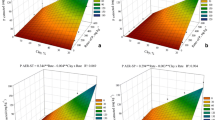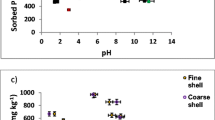Abstract
Rates of exchange of K with Ca for fine (0·2–2 µm) and coarse (54–75 µm) and for thin and thick (37–45 µm) phlogopite particles were determined using a repeated batch technique, which gave a measure of K selectivity.
Potassium selectivity of the fine fraction was higher than that of the coarse one throughout the exchange process in which 93 per cent of the total K was exchanged from the fine fraction and 100 per cent from the coarse one. Potassium selectivity of the thin 37–45 µm particles was higher initially than that of the thick 37–45 µm particles but the difference disappeared subsequently and practically 100 per cent of the total K was exchanged from both the thin and thick particles.
The results are interpreted as tentatively confirming the hypothesis that bending and deformation of elementary layers during K exchange increase with particle thickness, which in turn increase K exchange and decrease K selectivity.
The K exchange curves for the fine and coarse phlogopite fractions suggest that in natural conditions, as in soils, where K is not continuously removed from solution, vermiculization of coarse mica particles may be not only more complete but also more rapid than vermiculization of fine mica particles.
Résumé
Les taux d’échange de K contre Ca pour des particules de phlogopite fines (0, 2–2 µm) ou grossières (54–75 µm) et minces ou épaisses (37–45 µm) ont été déterminés au moyen d’une technique d’échange en milieu fermé avec contacts répétés, ce qui a donné une mesure de la sélectivité pour K.
La sélectivité pour le potassium de la fraction fine est plus élevée que celle de la fraction grossière, sur la totalité d’un processus d’échange dans lequel 93% seulement du potassium total ont été échangés avec la fraction fine, pour 100%, avec la fraction grossière. La sélectivité pour le potassium des particules 37–45 µm minces est initialement plus élevée que celle des particules 37–45 µm épaisses, mais, par la suite, la différence disparaît, et pratiquement 100% du K total sont échangés aussi bien avec les particules minces qu’avec les particules épaisses.
On interprète ces résultats en considérant qu’ils confirment, au moins temporairement l’hypothèse selon laquelle la courbure et la déformation des feuillets élémentaires pendant l’échange de K augmentent avec l’épaisseur des particules, ce qui augmente ensuite l’échange de K et diminue la sélectivité du minéral pour cet ion.
Les courbes d’échange de K pour les fractions fines et grossières de la phlogopite suggèrent que dans les conditions naturelles, comme dans les sols, là ou K ne disparait pas de la solution d’une façon continue, la vermiculitisation des particules grossières du mica peut être non seulement plus complète mais aussi plus rapide que la vermiculitisation des particules fines du même mica.
Kurzreferat
Die Austauschraten von K durch Ca wurden an feinkörnigen (0,2–2 µm) und groben (54–75 µm) sowie an dicken und dünnen (37–45 µm) Phlogopit-Teilchen bestimmt. Es wurde ein Austauschverfahren gewählt, das durch aufeinanderfolgende Gleichgewichtseinstellungen ein Maß für die K-Selektivität ergab.
Die K-Selektivität der feinen Fraktion war während des gesamten Austauschvorganges, in dessen Verlauf 93% des Gesamtkaliums aus der feinen und 100% aus der groben Fraktion ausgetauscht wurden, größer als die der groben Fraktion. Die K-Selektivität der dünnen 37–45 µm-Teilchen war anfangs größer als die der dicken 37–45 µm-Teilchen, jedoch verschwand der Unterschied nach und es wurden praktisch 100% des Gesamtkaliums sowohl aus den dünnen als auch aus den dicken Teilchen ausgetauscht.
Die Ergebnisse wurden als vorläufige Bestätigung der Hypothese gedeutet, daß Verbiegung und Verformung der Elementarschichten während des K-Austausches mit der Teilchendicke zunehmen, wodurch wiederum der K-Austausch erhöht und die K-Selektivität erniedrigt wird.
Die K-Austauschkurven der feinen und der groben Phlogopit-Fraktionen läßt vermuten, daß unter natürlichen Bedingungen—wie in Böden—, wo K nicht ständig aus der Lösung entfernt wird, die Vermiculitisierung der groben Glimmerteilchen nicht nur vollständiger, sondern auch schneller verläuft als die Vermiculitisierung der feinen Glimmerteilchen.
Резюме
Посредством повторного порционного метода определяли скорость обмена К с Са в мелких (0,2–2 µm) и крупных (54–75 µm), также в тонких и толстых (37–45 µm) частицах флогопита, давшего некоторую селективность по отношению к К.
Селективность мелких частиц по отношению к калию была выше, чем крупных в течение всего процесса обмена во время которого общий обмен К в мелких фракциях = 93 % а в крупных 100%. Селективность тонких 37–45 µm частиц по отношению к калию первоначально была выше, чем толстых частиц 37–45 µm, но позднее разница эта исчезла и произошел почти что 100% обмен К как в тонких так и в толстых частицах.
Результаты ориентировочно подтверждают гипотезу, что изгиб и деформация элементарных слоев во время обмена К повышается если частицы толстые, что в свою очередь ускоряет обмен К и понижает селективность по отношению к К.
Кривая обмена К в мелких и крупных частицах флогопита ведет на мысль, что в естественных условиях таких как в почве, где непрерывно из раствора не удаляется К, вермикулизация крупных частиц слюды может быть не только более полная, но также и более быстрая, чем вермикулизация мелких частиц.
Similar content being viewed by others
References
Bassett, W. A. (1959) The origin of the vermiculite deposits at Libby, Montana: Am. Mineralogist 44, 282–299.
Brown, J. L. and Rich, C. I. (1968) High-resolution electron microscopy of muscovite: Science 161, 1135–1137.
Correns, C. W. (1961) The experimental chemical weathering of silicates: Clay Minerals Bull. 4, 249–265.
De Haan, F. A. M., Bolt, G. H. and Pieters, B. G. M. (1965) Diffusion of potassium—40 into an illite during prolonged shaking: Soil Sci. Soc. Am. Proc. 29, 528–530.
Hsu, P. Ho. (1963) Effect of initial pH, phosphate, and silicate on the determination of aluminum with aluminon: Soil Sci. 96, 230–238.
Mortland, M. M. and Lawton, K. (1961) Relationships between particle size and potassium release from biotite and its analogues: Soil Sci. Soc. Am. Proc. 25, 473–476.
Reichenbach, H. Graf von. (1968) Cation exchange in the interlayers of expansible layer silicates: Clay Minerals 7, 331–341.
Reichenbach, H. Graf von and Rich, C. I. (1969) Potassium release from muscovite as influenced by particle size: Clays and Clay Minerals 17, 23–29.
Shapiro, L. and Brannock, W. W. (1956) Rapid analysis of silicate rocks: U.S. Geol. Surv. Bull. 1036 C, 19–55.
Scott, A. D. (1968) Effect of particle size on interlayer potassium exchange in micas: Trans. 9th Int. Congr. Soil Science 3, 649–660.
Scott, A. D. and Smith, S. J. (1967) Visible changes in macro mica particles that occur with potassium depletion: Clay and Clay Minerals 15, 357–373.
Author information
Authors and Affiliations
Additional information
Support for this work by a grant (GA-18053) from the National Science Foundation is gratefully acknowledged.
Rights and permissions
About this article
Cite this article
Ross, G.J., Rich, C.I. Effect of Particle Thickness on Potassium Exchange from Phlogopite. Clays Clay Miner. 21, 77–81 (1973). https://doi.org/10.1346/CCMN.1973.0210202
Received:
Published:
Issue Date:
DOI: https://doi.org/10.1346/CCMN.1973.0210202




